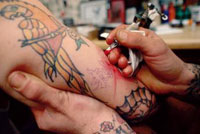Tattoo Aftercare
After you take the tattoo plunge, proper tattoo aftercare is vital – so be sure to get instructions before you leave. Nowadays, as long as you go to a reputable and professional facility, getting a tattoo poses very little health risk. The horror stories you may have heard about tattoo allergies or infections belong mainly in the past. That doesn’t mean you don’t have to be careful, though – for maximum enjoyment and minimum grief, you need to follow certain tattoo aftercare instructions.
Protect Your New Tattoo From Sun and Water

A fresh tattoo
New tattoo aftercare is mainly a matter of keeping the tattoo protected. Right after you get the tattoo, it will probably be covered with a gauze pad and bandage. Keep this on for the first ten hours or so, then remove it. While your skin is healing, make sure that there is nothing rubbing against the tattoo. Depending on where your tattoo is, this may or may not be a problem. For example, if you have a new tattoo on your ankle, you might need to avoid wearing socks while it heals. For a tattoo on your lower back, make sure that the waistband of your pants is loose enough so that it doesn’t rub.
Here’s another tattoo aftercare consideration - despite the fact that it’s the best time to show skin, summer may not be the optimal time to get a tattoo. New tattoos need to be protected from both sun and water. If you do go out in the sun, keep your tattoo covered, or slather it with sunscreen. Newly tattooed skin is too sensitive to be exposed to the summer sun unless it is protected, and sun exposure can also cause tattoos to fade before their time. Water is also a concern – sadly, after you get new tattoo, you need to avoid soaking it in water for about three weeks, and that means no swimming or water sports. Generally speaking, the tattoo doesn’t need to stay absolutely dry, but it shouldn’t soak – so a quick shower is okay, but soaking in the tub or going for a swim isn’t.
Prevent Tattoo Infection

Keep it clean
The risk of infection from a tattoo is nowhere near as high as it used to be, because the proper precautions are taken. Mainly this means that your skin will be sterilized before the tattooing starts, and most importantly, a new needle (not a ‘cleaned’ or ‘sanitized’ one) will be used. But in this day and age, any professional will be well aware of these precautions, so you probably have nothing to worry about. Still, an essential part of tattoo aftercare is checking for infection. Signs of infection include red, inflamed, puffy looking skin and tenderness. A tattoo that is healing properly should not be tender to the touch after the first couple of days. If it seems to be getting more sensitive rather than less, or if there are any other signs of infection, it may be time to get it checked by a health professional.
Dealing with a new tattoo isn’t difficult – it just requires a bit of care, and clear aftercare instructions. These steps will ensure that your tattoo is not a health risk, and that it will heal quickly. Because tattoo aftercare also involves using sunscreen and moisturizer, it can help ensure that your new tattoo won’t fade significantly for years to come.